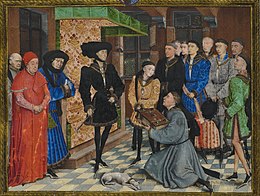
Back الأراضي المنخفضة البرغونية Arabic Países Baxos Borgoñonos AST Бургундскія Нідэрланды Byelorussian Бургундска Нидерландия Bulgarian Països Baixos Borgonyons Catalan Burgundské Nizozemí Czech De burgundiske Nederlande Danish Burgundische Niederlande German Βουργουνδικές Κάτω Χώρες Greek Burgonjaj Malaltaj Landoj Esperanto
It has been suggested that this article be merged with Burgundian inheritance in the Low Countries. (Discuss) Proposed since December 2024. |
Burgundian Netherlands Burgundiae Belgicae (Latin) Pays-Bas bourguignons (French) Bourgondische Nederlanden (Dutch) Burgundesch Nidderlanden (Luxembourgish) Bas Payis borguignons (Walloon) | |
|---|---|
| 1384–1482 | |
 The Burgundian Netherlands at the end of Charles the Bold's reign (1477) | |
| Status | Personal union of Imperial and French fiefs |
| Capital | None Mechelen (1473–1477) |
| Common languages | Dutch, Low Saxon, West Frisian, Walloon, Luxembourgish, French |
| Religion | Roman Catholicism |
| Government | Composite monarchy |
| Legislature | States General of the Netherlands |
| Historical era | Late Middle Ages |
• Established | 1384 |
• Disestablished | 1482 |

| History of the Low Countries | ||||||||
|---|---|---|---|---|---|---|---|---|
| Frisii | Belgae | |||||||
| Cana– nefates |
Chamavi, Tubantes |
Gallia Belgica (55 BC–c. 5th AD) Germania Inferior (83–c. 5th) | ||||||
| Salian Franks | Batavi | |||||||
| unpopulated (4th–c. 5th) |
Saxons | Salian Franks (4th–c. 5th) |
||||||
| Frisian Kingdom (c. 6th–734) |
Frankish Kingdom (481–843)—Carolingian Empire (800–843) | |||||||
| Austrasia (511–687) | ||||||||
| Middle Francia (843–855) | West Francia (843–) |
|||||||
| Kingdom of Lotharingia (855– 959) Duchy of Lower Lorraine (959–) |
||||||||
| Frisia | ||||||||
Frisian Freedom (11–16th century) |
County of Holland (880–1432) |
Bishopric of Utrecht (695–1456) |
Duchy of Brabant (1183–1430) Duchy of Guelders (1046–1543) |
County of Flanders (862–1384) |
County of Hainaut (1071–1432) County of Namur (981–1421) |
P.-Bish. of Liège (980–1794) |
Duchy of Luxem- bourg (1059–1443) | |
Burgundian Netherlands (1384–1482) |
||||||||
Habsburg Netherlands (1482–1795) (Seventeen Provinces after 1543) |
||||||||
Dutch Republic (1581–1795) |
Spanish Netherlands (1556–1714) |
|||||||
Austrian Netherlands (1714–1795) |
||||||||
United States of Belgium (1790) |
R. Liège (1789–'91) |
|||||||
Batavian Republic (1795–1806) Kingdom of Holland (1806–1810) |
associated with French First Republic (1795–1804) part of First French Empire (1804–1815) | |||||||
Princip. of the Netherlands (1813–1815) |
||||||||
| Kingdom of the Netherlands (1815–1830) | Gr D. L. (1815–) | |||||||
Kingdom of the Netherlands (1839–) |
Kingdom of Belgium (1830–) | |||||||
Gr D. of Luxem- bourg (1890–) | ||||||||
The Burgundian Netherlands (Latin: Burgundiae Belgicae, French: Pays-Bas bourguignons, Dutch: Bourgondische Nederlanden, Luxembourgish: Burgundesch Nidderlanden, Walloon: Bas Payis borguignons) were those parts of the Low Countries ruled by the Dukes of Burgundy during the Burgundian Age between 1384 and 1482. Within their Burgundian State, which itself belonged partly to the Holy Roman Empire and partly to the Kingdom of France, the dukes united these lowlands into a political union that went beyond a personal union as it gained central institutions for the first time (such as the States General).
The period began with Duke Philip the Bold taking office as count of Flanders and Artois in 1384 and lasted until the death of Duchess Mary of Burgundy in 1482 after which the Burgundian State was dissolved, and the Low Countries came under the rule of the Habsburg monarchy by inheritance.
In the 15th century, it was customary to refer to the Low Countries where the Duke of Burgundy ruled and usually resided as les pays de par-deçà meaning "the lands over here" as opposed to Burgundy proper (in Central France) which was designated les pays de par-delà meaning "the lands over there" (see also Terminology of the Low Countries).

